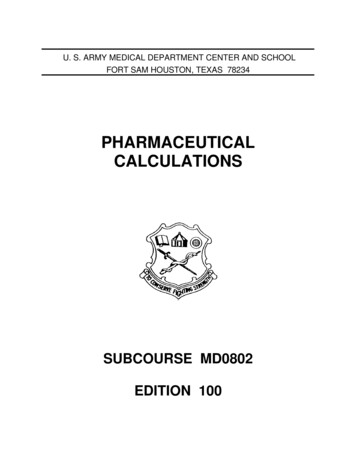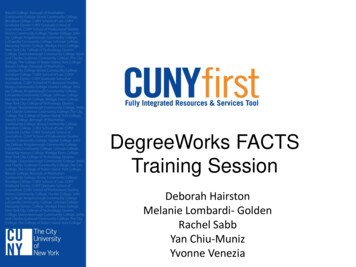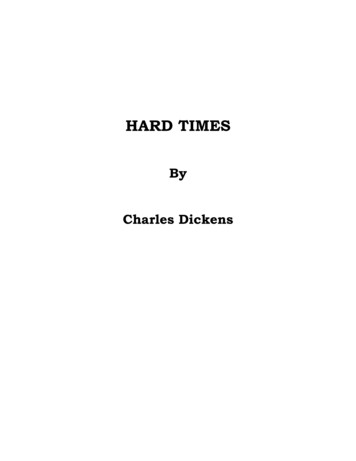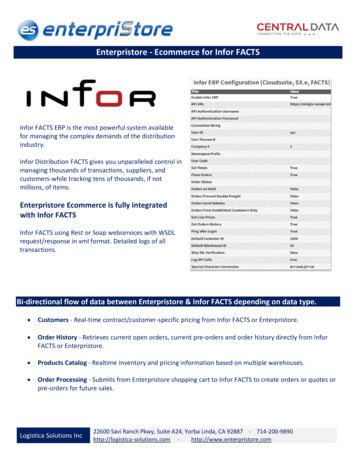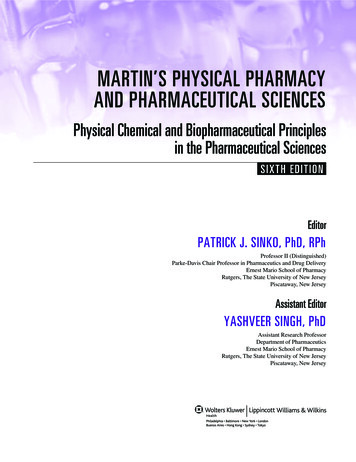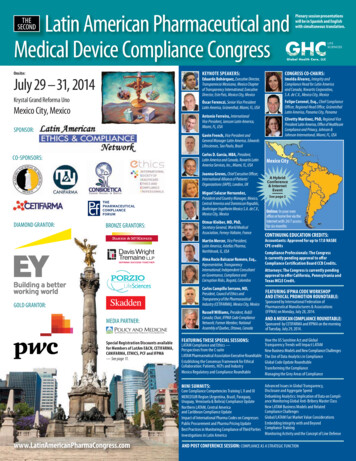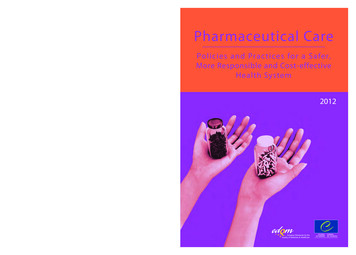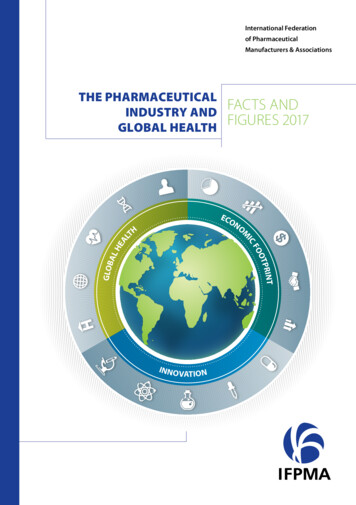
Transcription
International Federationof PharmaceuticalManufacturers & AssociationsFACTS ANDFIGURES 2017ECONOTHTPRINOTFOICMGLOBALHEALTHE PHARMACEUTICALINDUSTRY ANDGLOBAL HEALTHIN N OVATION
This compendium of facts and figuresrelating to the pharmaceutical industry andglobal health aims to provide a snapshot ofthe work this industry undertakes today.This publication examines the most recentdata on pharmaceutical innovation andglobal health, access to medicines andhealthcare systems, as well as the economicfootprint of the pharmaceutical industry.The information further illustrates that theresearch-based pharmaceutical industryis one of the most innovative sectors inthe world, which over the past century hasplayed a unique role in developing new andimproved medicines and vaccines to preventand treat diseases.This is a unique industry. IFPMA membersemploy over two million of people who areproud to participate in this crucial endeavor.Their work saves millions lives and helpsthose suffering from disease to recoverand lead more productive lives. IFPMApresents this publication to underline theongoing commitment of the research-basedpharmaceutical industry to improving thequality of life for all people worldwide.We hope that sharing some of the mostrecent and relevant facts and figuresrelating to our work can add value toevidence-based policymaking in the globalhealth arena.
AbbVie
Table of contentsTABLE OF CONTENTS.3INDEX OF FIGURES, CHARTS AND TABLES.4KEY FACTS.5CHAPTER 1: PHARMACEUTICAL INNOVATION AND PUBLIC HEALTH.7A Look into the Pharmaceutical Industry R&D Pipeline . 8Pharmaceutical Industry R&D Investments. 13Pharmaceutical R&D and its Impact on Global Health.16Incremental Innovation. 20R&D for Diseases that Disproportionately Affect the Developing World. 21CHAPTER 2: ACCESS TO MEDICINES AND HEALTHCARE SYSTEMS. 25Distribution of Wealth and Health Outcomes. 25Healthcare Spending and Workforce. 27Barriers to Access to Medicines and Healthcare .31The Role of Pharmaceutical Products in Healthcare. 33Pharmaceutical Industry’s Contribution to Improving Global Health .35Healthcare Achievements and Challenges. 38CHAPTER 3: ECONOMIC FOOTPRINT OF THE PHARMACEUTICAL INDUSTRY .41Pharmaceutical R&D and Production. 42Pharmaceutical Industry Employment. 43Transfer of Technology. 46Trade in Pharmaceuticals. 47The Pharmaceutical Market.51Generic versus Branded Pharmaceutical Products .52Conclusion.53ANNEXES. 54Annex 1: Key Health Numbers (2014).55Annex 2: Pharmaceutical Market (2014). 65Annex 3: Pharma Economic Footprint (2014).74
Index of figures, charts and tablesFIGURESFigure 1:. 8The Research and DevelopmentProcessFigure 2:. 13Pharmaceutical R&D NetworksFigure 3:. 17Medicines in Development(Selected Categories)Figure 4:. 20Categories ofPharmaceutical InnovationFigure 5:. 28The WHO Health System FrameworkFigure 6:. 29Relative Density of Physicians per 1,000Population (Latest Available Year)Figure 7:. 34Five-year Survival Rates forVarious Cancers, 1989-1993 vs2008-2012Figure 8:. 35Health Partnerships Undertakenby Research-based PharmaceuticalCompaniesChart 9:. 19Reducing Number of Formulationsper Day Increases Percentage ofDiabetes Patients Retained onTreatmentChart 10:. 22Total Funding for NeglectedDiseases by Funder Type, 2007-2014Chart 11:. 26Evolution GDP per Capita inSelected CountriesChart 12:. 27Correlation between Income perPerson and Life Expectancy, 2013Chart 13:. 30Total Health Expenditure as aPercentage of GDP, and Public HealthExpenditure as a Percentage of theTotal Health Expenditure, 2014Chart 14:. 30Total Pharmaceutical Salesas a Percentage of HealthcareExpenditure, 2014Chart 15:. 31Examples of “Hidden” Costs ofPharmaceutical ProcurementFigure 9:. 47Critical Factors for CreatingFavorable Conditions forPharmaceutical Technical TransfersChart 16:. 33Pharmaceutical Sales per Capita inSelected Low and Middle IncomeCountries, 2015Figure 10:. 53Spending by Geography, Segmentand Disease Area in 2020Chart 17:. 34Impact of Medication Adherencein Chronic Vascular Disease,2005–2008CHARTSChart 18:. 37Treatments Donated and Sold atCost in Developing Countries forNTDs, 2009-2014Chart 1:. 9Medicines in Development byRegulatory Phase Globally, 2015Chart 2:. 10Phase Transition Success Ratesand Likelihood of Approval for AllMedicines and ModalitiesChart 3:. 11Clinical Phase Trends Globally,2007-2016Chart 4:. 11Number of New Chemical andBiological Entities Approved by theUS Food and Drug Administration,2004-2014Chart 5:. 15Pharmaceutical R&D SpendingChart 6:. 15R&D Investments by SectorChart 19:. 38Life Expectancy Evolution inSelected CountriesChart 20:. 39Infant Mortality in SelectedCountriesChart 21:. 43Development of the Gross ValueAdded and the Annual GrowthRate (Red Line) in Comparison tothe Worldwide GDP (Blue Line)Chart 22:. 45Employment (Headcount inThousands) and Shares ofOriginators, Generics and OtherDrugs, 2014Chart 7:. 18Decline in HIV/AIDS Death RatesChart 23:. 48Pharmaceutical Trade andForecast, ChinaChart 8:. 19Improving Adherence to MedicinesIncreases ProductivityChart 24:. 48Pharmaceutical Trade andForecast, JapanChart 25:. 49Pharmaceutical Trade andForecast, IndiaChart 26:. 49Pharmaceutical Trade andForecast, SingaporeChart 27:. 50Pharmaceutical Trade andForecast, United KingdomChart 28:. 50Pharmaceutical Trade andForecast, United StatesChart 29:.51Global Spending on MedicinesChart 30:. 52Spending by GeographyTABLESTable 1:. 9R&D Costs in the US, 2014Table 2:. 10Medicines in Development for NonCommunicable Diseases (NCDs)Table 3:. 12Trends in Clinical Trial ProtocolComplexityTable 4:.14Enabling Factors of PharmaceuticalInnovationTable 5:. 23Industry R&D Activity Relatingto NTDsTable 6:. 32Selected Infrastructure Indicators,2015Table 7:.41Key Indicators of thePharmaceutical Industry’sEconomic Footprint in EuropeTable 8:. 42Regional Breakdown of the GrossValue Added in the PharmaceuticalIndustry (USD Billion)Table 9:. 43Production Value of thePharmaceutical IndustryTable 10:. 44Regional Breakdown ofEmployment in the PharmaceuticalIndustry (Headcount in Thousands)Table 11:. 45Employee Compensation in thePharmaceutical IndustryTable 12:. 46Selected Examples of TechnologyTransfer – Manufacturing Protocolsand Entrepreneurial Know-how
Key factsRESEARCH & DEVELOPMENTTHE RESEARCH-BASEDPHARMACEUTICAL INDUSTRY’S It takes 10–15 years to develop a medicine orCONTRIBUTION TO A HEALTHYvaccine.SOCIETYThe research-based pharmaceutical industrycurrently spends over USD 149.8 billion on R&D In 2014, the number of drugs in developmentfor particular disease areas were:In 2015, 56 new pharmaceuticals were Cancer: 1,919launched, out of more than 7,000 compounds Cardiovascular diseases: 563in development. Neurology: 1,308In 2011-2015, the number of new chemical or Infectious diseases: 1,261biological entities launched on the world market per year. For every USD 1 spent on new medicines forincreased to 226 from 146 a decade earlier.hypertension in the United States USD 10.11 inIn 2014, 5 of the 11 leading global R&D firmsmedical spending is saved.were pharmaceutical companies.THE PHARMACEUTICAL MARKETINDUSTRY’S CONTRIBUTION TODISEASES THAT DISPROPORTIONATELY Drugs and vaccines against malaria are The United States share of the global marketwill increase from 40.3% in 2015 to 41% in 2020,campaigns helped reduce the number ofwhile Europe’s share will fall from 13.5% in 2015deaths from measles in Africa by 79%.to 13.1% in 2020.In 2014, there were 401 drugs in the pipelineHIV/AIDS.Currently, IFPMA members have 119 ongoingR&D projects related to neglected tropicaldiseases. compared to 23% in 2015. Between 2000 and 2014, immunizationfor diabetes and 208 drugs in development for Pharmerging countries will account for 25% ofglobal spending on pharmaceuticals by 2020,estimated to have saved, between 2011 and2015, 1.14 million African children’s lives.The global pharmaceutical market will reachnearly USD 1,430 billion by 2020.AFFECT THE DEVELOPING WORLDIn 2014, industry was the third largest funderfor neglected diseases research, investing overUSD 534 million.
Novartis
Chapter 1 Pharmaceutical Innovation and Public Health7Chapter 1PHARMACEUTICAL INNOVATIONAND PUBLIC HEALTHThe research-based pharmaceutical industry plays a unique role in developing newmedicines and vaccines to prevent and treat diseases, and improve the lives of patientsworldwide. Its key contribution to global health is turning fundamental research intoinnovative treatments. Industry’s success rests on continuous innovation – for theprevention and treatment of common, complex, and neglected diseases, and forimprovements in existing treatments. Despite often challenging business and regulatoryconditions, the industry undertakes investments that are considerably more risky thanthose in most high-technology sectors. By investing billions of dollars and thousands ofscientist-hours, it pushes the limits of science, fosters medical progress, and contributesto the prosperity of society.The private sector produces nearly all the medicines and vaccines on the market. When apharmaceutical company invests in research and development (R&D) of new medicinesand vaccines, it first screens for chemical and biological compounds that exhibit thepotential for treating new or existing conditions. R&D begins once researchers identifya promising compound among, on average, 5,000–10,000 screened. Researchers thenextensively test the compound to ensure its efficacy and safety, a process that can take10 to 15 years1. To illustrate, in 2015 56 new medicines were launched2, while currentlymore than 7,000 compounds are at different stages of development globally3. Thedifference in these numbers highlights the many research hurdles to be overcomebefore compounds can be developed into safe and effective medicines.1PhRMA (2016) 2016 Biopharmaceutical Research Industry Profile. Washington DC: Pharmaceutical Research andManufacturers of America. ceutical-industry-profile.pdf//2Evaluate Pharma (2016) World Preview 2016, Outlook to 2022. London: Evaluate Ltd., p 29. s/wp16.pdf3PhRMA (2016) Chart Pack Biopharmaceuticals in Perspective. Washington DC: Pharmaceutical Research and Manufacturers ofAmerica, p 22. k-biopharmaceuticals-in-perspective.pdf
Facts & Figures 20178Figure 1: The Research and Development Process4RESEARCHDrugDiscoveryScreeningof 5,000to Clinical TrialsINDPhase IPhase IIPhase unteersAPPROVALNDARegulatoryReview andMarketAuthorizationPostScale-Up tomarketingManufacturingSurveillancePhase IVTrialsDuration:3-6 yearsDuration:6-7 yearsDuration:0.5-2 yearsDuration:ongoingShare of budget:21.5%Share of budget:up to 65%Share of budget:up to 3.5%Chances of success: 0.01%Chances of success:65% in Phase I40% in Phase II50% in Phase IIIShare ofbudget:up to 10%Chances forReturn onInvestment(ROI):1:3A Look into the Pharmaceutical Industry R&D PipelineToday, the cost of developing a successful medicine can exceed, according to somestudies, USD 2.6 billion5 compared to USD 179 million in 1970s6. This increase reflects thevarious technical, regulatory and economic challenges facing R&D pipelines. Companiesoften experience lost R&D investments (that is, R&D expenditures that do not materializein a market-approved medicine) because pharmaceutical R&D is marked by high failurerates. An early-phase compound may have a promising outlook, but only preclinicaland clinical trials will demonstrate its efficacy, quality, and safety. In addition, lostinvestments may increase when a failure occurs in later R&D phases. A phase III failure issignificantly more costly than a preclinical failure because each phase is associated witha certain amount of required investment.4Pugatch Consilium (2015) Measuring the Global Biomedical Pulse. iMasi, J. A.; Grabowskib, H. G.; Hansenc, R. W. (2016) Innovation in the Pharmaceutical Industry: New Estimates of R&D Costs.Journal of Health Economics. doi: 10.1016/j.jhealeco.2016.01.0126PhRMA (2016) 2016 Biopharmaceutical Research Industry Profile. Washington DC: Pharmaceutical Research andManufacturers of America, p 47. ceutical-industry-profile.pdf//
Chapter 1 Pharmaceutical Innovation and Public Health9Table 1: R&D Costs in the US, 20147FUNCTIONUSD MILLIONS H A R E ( %)Prehuman/Preclinical11,272.721.2Phase I4,722.08.9Phase II5,697.810.7Phase III15,264.428.7Approval2,717.75.1Phase IV8,827.016.6Uncategorized4,751.58.9TOTAL R&D53,253.1100Chart 1: Medicines in Development by Regulatory Phase Globally, 2015870006000No. Medicines500040003000200010000PreclinicalPhase IPhase IIPhase IIIRegulatory Review7PhRMA (2016) PhRMA Annual Membership Survey. Washington DC: Pharmaceutical Research and Manufacturers of America,p 6. l-membership-survey-results.pdf8Pharma Intelligence (2016) Pharma R&D Annual Review 2016. London: Pharmaprojects, p 6. nnual-Report-2016.pdf
Facts & Figures 201710Chart 2: Phase Transition Success Rates and Likelihood of Approval for AllMedicines and Modalities990%85,3%All deseases, all modalities80%70%63,2%Probality of Success60%58,1%50%40%30,7%30%20%9,6%10%0Phase I toPhase IIPhase II toPhase IIIPhase III toNDA/BLANDA/BLA toApprovalPhase I toApprovalTable 2: Medicines in Development for Non-Communicable Diseases (NCDs)10PHASE IPHASE IIPHASE IIIR E G U L AT O R YREVIEWT O TA , Biomedtracker and Amplion (2016) Clinical Development Success Rates 2006-2015, p 7. s Group (2013) Innovation in the Biopharmaceutical Pipeline: A Multidimensional View. http://www. s/2012 Innovation in the Biopharmaceutical Pipeline.pdf
Chapter 1 Pharmaceutical Innovation and Public Health11Chart 3: Clinical Phase Trends Globally, 5000Phase I20072008Phase II2009201020112012Phase III2013201420152016* 2016 figures forecastedChart 4: Number of New Chemical and Biological Entities Approved by the US Foodand Drug Administration, 2004-201412605040302010020052006200720082009New Chemical Entity (NCE)201020112012201320142015New Biological Entity (NBE)11Pharma Intelligence (2016) Pharma R&D Annual Review 2016. London: Pharmaprojects, p 7. nnual-Report-2016.pdf12Evaluate Pharma (2016) World Preview 2016, Outlook to 2022. London: Evaluate Ltd., p 29. s/wp16.pdf
Facts & Figures 201712Rising R&D costs have been accompanied by more stringent testing requirements.The number of new chemical or biological entities (NCEs and NBEs) launched on theworld market increased to 226 in the 2011-2015 period compared with 146 a decadeearlier13. In addition, once a medicine receives regulatory approval, national healthauthorities require companies to track and report patients’ experiences (referred to as“pharmacovigilance”). These reporting requirements are becoming stricter, raising theinvestment cost in a given medicine as long as it is being marketed.These challenges have not diminished the industry’s innovative drive but have ratherencouraged it to adopt new models of innovation. Open collaboration and newbusiness models such as joint ventures between pharmaceutical companies and otherexternal entities are ways to increase the productivity of pharmaceutical research byfacilitating partnerships involving academia and the public and private sectors. Thesecollaborations facilitate the sharing of expertise, know how, and technologies such ascompound databases.Table 3: Trends in Clinical Trial Protocol Complexity142 0 0 0 -2 0 0 32 0 0 8 -2 0 11% CHANGETotal Procedures per Trial Protocol (median) (e.g.,bloodwork, routine exams, x-rays, etc.)105.9166.657%Total Investigative Site Work Burden (median units)28.947.564%Total Eligibility Criteria314648%Clinical Trial Treatment Period (median days)14017525%Number of Case Report Form Pages per Protocol(median)55171211%13EFPIA (2016) The Pharmaceutical Industry in Figures. Brussels: European Federation of Pharmaceutical Industries andAssociations, p 8. pharmaceutical-industry-in-figures-2016.pdf14PhRMA (2016) Chart Pack Biopharmaceuticals in Perspective. Washington DC: Pharmaceutical Research and Manufacturers ofAmerica, p 37. k-biopharmaceuticals-in-perspective.pdf
Chapter 1 Pharmaceutical Innovation and Public Health13Figure 2: Pharmaceutical R&D Networks15CROsGovernmentRegulatoryAgenciesClinical triallicainCl AR6-7 YEARSSAcademiaEarly Phase4–6 Y reseEAaRS rchSMEsCompanyillanceurvegS SUtinke INUOarM ONTst CPoe EPr 1 YPPP ��2 raYE tinAR gHealth CareProfessionalsPharmaceutical Industry R&D InvestmentsThe research-based pharmaceutical industry is estimated to have spent nearly USD 149.8billion globally on pharmaceutical R&D in 201516.Of all industrial sectors, the research-based pharmaceutical industry has consistentlyinvested the most in R&D, even in times of economic turmoil and financial crisis.Compared with other high-technology industries, the annual spending by thepharmaceutical industry is 5.5 times greater than that of the aerospace and defenseindustries, 5 times more than that of the chemicals industry, and 1.8 times more thanthat of the software and computer services industry17.Innovation cannot happen without a number of enabling conditions, such as access toworld-class researchers, political and financial stability, and a regulatory framework thatprotects and rewards innovation. All countries have the potential to foster innovationand improve the functioning of the innovation process.15IFPMA (2012) The New Frontiers of Biopharmaceutical Innovation. Geneva: International Federation of PharmaceuticalManufacturers & Associations, p 9. /2013/IFPMA IncrementalInnovation Feb 2013 Low-Res.pdf16Evaluate Pharma (2016) World Preview 2016, Outlook to 2022. London: Evaluate Ltd., p 27. s/wp16.pdf17European Commission (2015) The 2015 EU Industrial R&D Investment Scoreboard; p 50. http://iri.jrc.ec.europa.eu/scoreboard15.html
Facts & Figures 201714Table 4: Enabling Factors of Pharmaceutical Innovation18E A R LY S TAG ER ESEA RCHCLINICA LTRIALS World class research institutionsHighly trained workforce (retained or attracted back to the country)Clusters of innovative companies providing support on coretechnologies (high throughput screening, gene sequencing etc.)Partnership encouraging environment Efficient regulatory system for appraising clinical trials designSupportive and well-regulated system for enrolmentStrong medical schools and clinicians for designingManaging and reporting trials designGrowing market receptive to innovationIn the United States, R&D investments of pharmaceutical companies have grownconsistently over the past 15 years, and more than doubled the publicly-funded NationalInstitutes of Health’s (NIH)19 expenditures in 201420. R&D intensity by the researchbased pharmaceutical industry in Japan amounts to 13.3%, in the US to 17.1%, and inthe European Union to 13.3%21. In 2014, the pharmaceutical industry registered 7,691patents through the Patent Cooperation Treaty (PCT) of the World Intellectual PropertyOrganization22. No other business sector has such high levels of R&D intensity.18Charles River Associates (2012), Policies that encourage innovation in middle-income countries. (Boston, MA: Charles RiverAssociates, 2012).19Part of the US Department of Health and Human Services, the National Institutes of Health (NIH) is the US medical researchagency, funding universities and research institutions in the US and around the globe.20NIH (National Institutes of Health) (2016) NIH Budget. http://www.nih.gov/about/budget.htm21European Commission (2015) The 2015 EU Industrial R&D Investment Scoreboard; p 53. O (2016) Patent Cooperation Treaty Yearly Review – The International Patent System. Geneva: World Intellectual PropertyOrganization, p 37. http://www.wipo.int/edocs/pubdocs/en/wipo pub 901 2016.pdf
Chapter 1 Pharmaceutical Innovation and Public Health15Chart 5: Pharmaceutical R&D Spending23150140USD 5Chart 6: R&D Investments by Sector24R&D investiment ( Billion)020406080100120Pharmaceuticals & BiotechnologyAutomobiles & PartsTechnology Hardware & EquipmentSoftware & Computer ServicesElectronic & Electrical EquipmentIndustrial EngineeringChemicalsAerospace & DefenceGeneral industrialsHealth Care Equipment & ServicesLeisure GoodsOther luate Pharma (2016) World Preview 2016, Outlook to 2022. London: Evaluate Ltd., p 27. s/wp16.pdf24European Commission (2015) The 2015 EU Industrial R&D Investment Scoreboard; p 50. http://iri.jrc.ec.europa.eu/scoreboard15.html
Facts & Figures 201716According to European Commission statistics, 5 of the 11 leading global R&D firms in2014 were pharmaceutical companies25. In 2014, R&D spending by the pharmaceuticalsand biotechnology sector grew by 8.7% from the previous year, strengthening itsposition as the top R&D investing sector26. These facts are a clear demonstration of thesignificant contribution the pharmaceutical sector makes to the world economy.Pharmaceutical R&D and its Impact on Global HealthPharmaceutical R&D has dramatically improved the lives of patients. Medicaldiscoveries, big and small, have increased life expectancy and resulted in a betterquality of life for many. Vaccines have proven to be one of the most effectivepreventative technologies in the fight against infectious diseases with an almostunparalleled impact on public health, including, but by no means limited to, riddingthe world of smallpox, driving polio to the brink of eradication, and virtually eliminatedmeasles, diphtheria and rubella in many parts of the world. Currently, vaccines savethe lives of over 2.5 million children each year. Between 2000 and 2014, immunizationcampaigns cut the number of deaths caused by measles by 79%27, with a reductionof 92% in Africa between 2000 and 200828. The new generation of vaccines is makingthe same kind of public health impact as their pioneering predecessors, dramaticallyreducing the burden of pneumococcal disease and rotavirus disease – two of thebiggest killers of children – and cancers caused by HPV (human papilloma virus). Since1928, scientists have discovered and developed 19 classes of antibiotics29. Currently,34 new antibacterial compounds are in development of which 15 are vaccines and 19small and large molecules30. With the help of major medical discoveries, the researchbased pharmaceutical industry has developed more than 35 antiretroviral treatmentsfor HIV/AIDS, essential to control of the epidemic31. More than 7,000 medicines are in25European Commission (2015) The 2015 EU Industrial R&D Investment Scoreboard; p 50. m27WHO (2016) Fact Sheet Measles. Geneva: World Health Organization. 28GAVI Alliance (2016) Measles Vaccine Support. Geneva: Gavi, the Vaccine Alliance. esources for the Future (2008) Extending the cure: Policy responses to the growing threat of antibiotic resistance.Washington DC: Resources for the Future. http://www.rff.org/RFF/Documents/ETC-06.pdf30IFPMA (2015) Rethinking the Way We Fight Bacteria. Geneva: International Federation of Pharmaceutical Manufacturers &Associations, p 25. /2015/IFPMA Rethinking the way we fightbacteria April2015 FINAL.pdf31U.S. Food and Drug Administration (2014) Antiretroviral Drugs Used in the Treatment of HIV Infection. atment/ucm118915.htm
Chapter 1 Pharmaceutical Innovation and Public Health17development worldwide, 208 drugs HIV/AIDS; 1,919 for cancer; 401 for diabetes; and563 for cardiovascular diseases32.Figure 3: Medicines in Development (Selected 1HIV/AIDSNEUROLOGY1,3081,9191,123Pharmaceutical progress has led to a dramatic decline in death rates for diseases such asHIV/AIDS, cancer, polio, and measles. For example, death rates for HIV/AIDS in the UnitedStates have fallen from 10.2 deaths per 100,000 people in 1990 to 2.0 deaths per 100,000people in 2014, a reduction of 80%34. The number of A
This compendium of facts and figures relating to the pharmaceutical industry and global health aims to provide a snapshot of the work this industry undertakes today.
